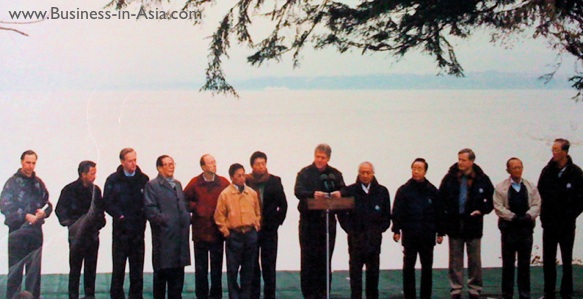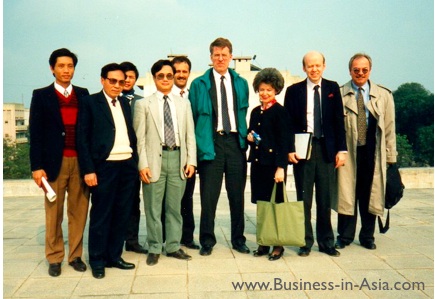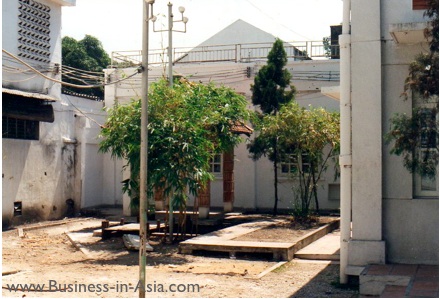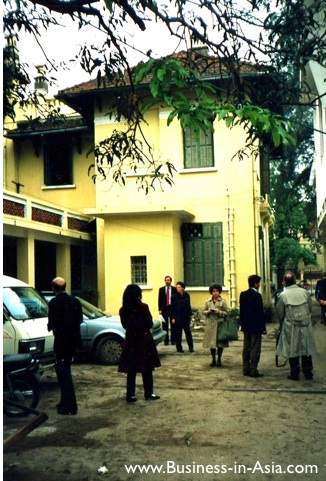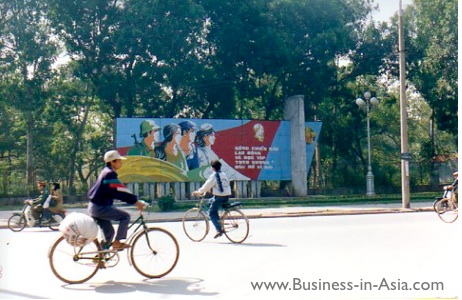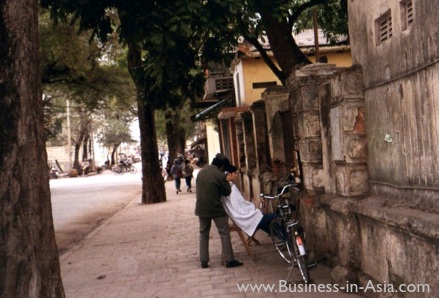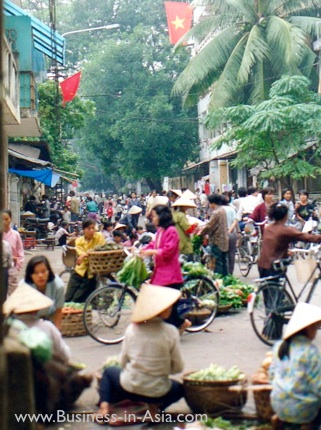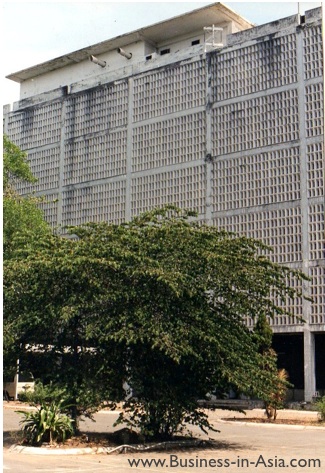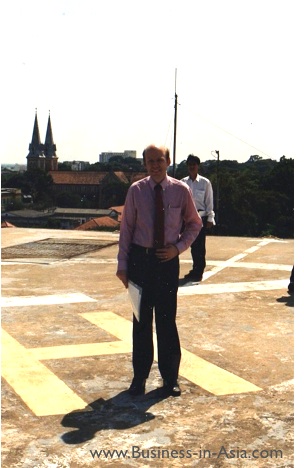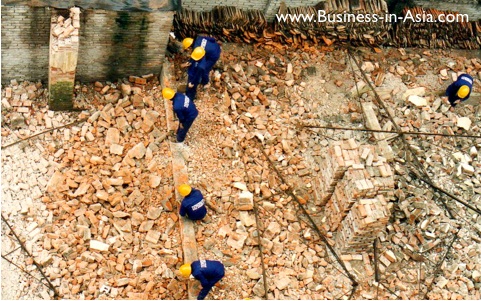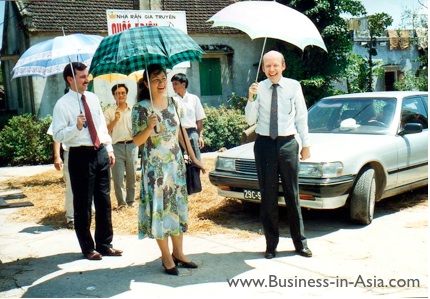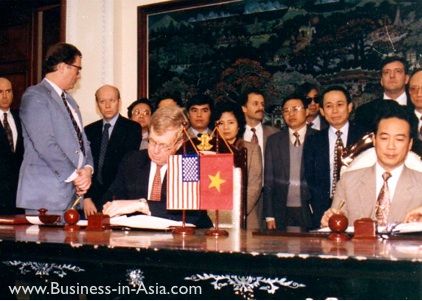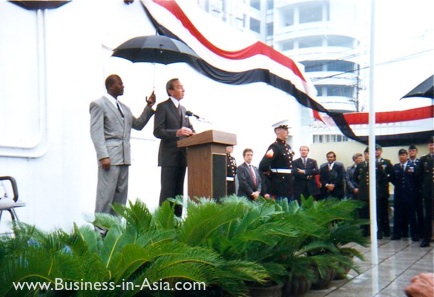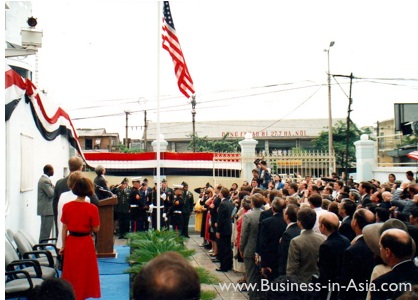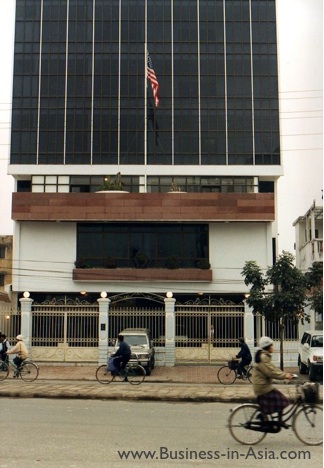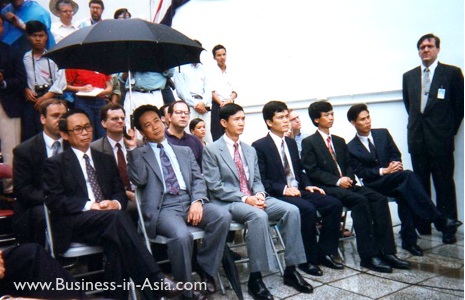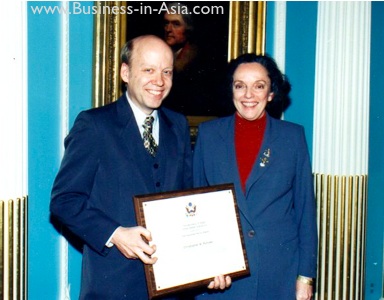On
July 11, 1995, President Clinton announced agreement on opening
diplomatic relations and on August 5, 1995 Secretary of State Warren
Christopher opened the U.S. Embassy which was in the same building as
the former U.S. Liaison Office, a building that the U.S. Embassy still
occupies. This brings up a question that I am often asked which
is why the U.S. built such an ugly and unrepresentative building for
what became the Embassy. The answer is we didn’t. In 1994
when we were trying to settle all the claims on both sides as to
properties owned by both sides, our biggest challenge was that prior to
1954 when the U.S. left Hanoi, we had owned only the U.S. Consulate
located in the center of the city. This was and is a large
property in relative terms in Hanoi but not suitable in size for what
we knew even then would be a large and growing mission given the
importance of Vietnam and our mutual interests. This assessment
has proven correct as the staffing at the U.S. Embassy is currently
well over 200 and continues to grow. Further, Hanoi in 1994 was a
very different place than it is today. There had been little
building in the years preceding and most buildings in Hanoi were old,
dilapidated and overcrowded. Finding a suitable building to
locate even a business office was a tremendous challenge. Finding
a building that could accommodate up to a 100 people was a near
impossibility.
In 1994, we had no large vacant site suitable for a building to be
constructed nor at that time was there much choice in vacant and even
occupied buildings as Vietnam was just starting to seriously open its
economy. Further many of us felt that it would take
the U.S. government so long to build a new Embassy because of security
and other reasons and that since neither side would be allowed to
finally open diplomatic relations until the U.S. side had a suitable
facility (please note that the former Vietnamese Embassy in the U.S.
was already judged to be satisfactory and in fact desirable by the
government of Vietnam at this point) that this situation required we
find some building in Hanoi to allow the U.S. to start
operations. This left the U.S. side and especially those who
argued for early opening of diplomatic relations with a problem - wait
for an adequate U.S. Embassy to be built(which would take 4-5 years,
possibly longer) or agree to occupy something we knew was not really
satisfactory and would inconvenience the new
Embassy and inhibit growth
but do it now so that diplomatic relations could be established
immediately. This would allow the U.S. and Vietnam to start
repairing their relationship now instead of waiting.
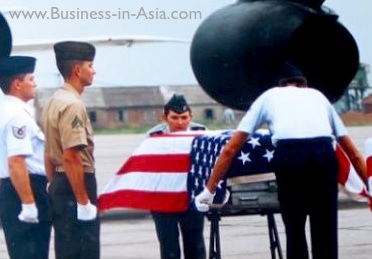
Picture above: The return of the
remains of POW-MIA at the airport in Vietnam. An always moving
experience.
|
I was firmly on the side that felt that
the relationship with Vietnam
was too important to wait and that we needed to start working with
Vietnam more closely on all issues including POW-MIA accounting,
economic relations, consular protection, etc. I argued with
others that we should not hold out for the ultimate but settle for
something now in terms of a building putting the establishment of
diplomatic relations as the highest priority. In retrospect this
may look reasonable but there were many high ranking individuals in the
State Department and in the government that were not in favor of a
quick opening of diplomatic relations and they tried to use this to
slow down progress. I in fact was required to fly to Bangkok at
one point by a senior officer in the Department and told on the phone
where it could not be intercepted to not be so forthcoming and to
realize that policy was made higher up in the government. |
In
any case, ultimately we settled on the building at 7 Lang Ha which
our contract driver had found and after much evaluation and negotiation
it was turned over to us by the Vietnamese side as part of the property
settlement. Over the months ahead we renovated the building which
was fairly new and tried to make it more suitable but I fully agree
that it was always a second class building. In fact, however, my
choice of the building was ultimately proven correct as a good interim
choice as when we accepted the building the Department agreed that if
we did so that they would expedite the approval and construction of a
new Embassy. Here 15 years later this has yet to start
construction which further proves my skepticism of Department promises
for a rapid construction of a new Embassy were well placed.
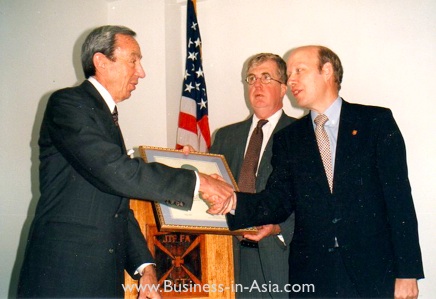
Picture above: Jim
Hall, Chief of U.S. Liaison Office, holds a Superior Honor Award
presented to me for my work in starting U.S. government ooperations in
Hanoi. I'm at far right.
|
Soon after we had settled in the
U.S. Embassy in Hanoi and
Secretary of State Warren Christopher had presided at the opening of
the Embassy, planning started for a U.S. Consulate in Ho Chi Minh City
(Saigon) which had always been planned as our next step.
Washington first agreed to allow me to have demolished some of the
outbuildings on the compound at the corner of Mac Dinh Chi and Le Duan
which we did in 1995. The main Embassy building which had housed
our large U.S. Embassy prior to 1975 was in bad shape. Wiring was
a shambles as was much of the plumbing system. The roof leaked
and the building although built to the highest bomb standards during
the war was really a relic of the 60s and 70s. Further, the
building would always be a reminder of the War with all its negative
baggage. We therefore argued for its destruction and for
construction of a new building on the site, a decision I totally
supported. Ultimately this decision won out and the building was
ultimately demolished. |
I flew recently into Ho Chi Minh City in September 2009. As I
flew in on a Delta/Northwest flight I marveled that in 1969 when I
served in the U.S. Army in Vietnam I had never thought that Delta nor
Northwest would be flying regularly scheduled service into Vietnam nor
would it become such a site for U.S. companies to invest and
work. In fact, a Northwest/Delta pilot recently remarked the same
thing to me. As I looked out on the lights of the city and the
surrounding provinces which even at 11 o’clock at night lit up the
countryside far outside the city center, I had to compare that to 1969
and even to 1994 when I returned when the countryside and often much of
the city was dark and unlit oftentimes from sunset.
|
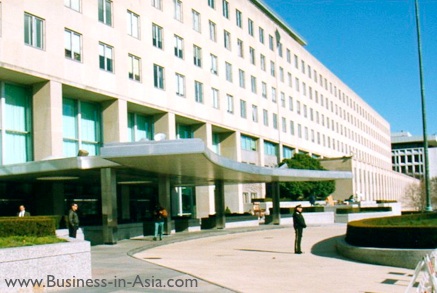
Picture above: The Department of
State in Washington DC.
|
Picture above: In 1999, at the
Department of State in Washington DC, I was honored to receive the U.S.
Department of States highest award for service, the Distinguished Honor
Award. Award was for my contribution to improving U.S.-Vietnam
relations. The award was presented by Undersecretary of State for
Management, Ms. Bonnie Cohen, and the ceremony was attended by family,
friends and colleages.
|
Vietnam is a very different place today. Engagement with Vietnam
has been good for the U.S. and it has been good for Vietnam.
Vietnam today is a vastly more prosperous country. Tens of
millions of people have been lifted out of poverty. As I spoke at
an Investment and Trade Conference jointly hosted by the U.S. Consulate
in Ho Chi Minh City and Binh Duong province (the hottest place for
investment in the whole country) to many U.S. and other businesses, I
had to reflect that Vietnam and the U.S. have much to join them and
that my small part in making that happen has been something that gives
me pride and a sense of
accomplishment.
About the
Author:
Christopher W. Runckel, a
former senior US diplomat who served in many counties in Asia, is a
graduate of the University of Oregon and Lewis and Clark Law School. He
served as Deputy General Counsel of President Gerald Ford’s
Presidential Clemency Board. Mr. Runckel is currently the principal and
founder
of Runckel &
Associates, a Portland, Oregon
based consulting company that assists businesses expand business
opportunities in Asia. (www.business-in-asia.com)
Until April of 1999, Mr.
Runckel was Minister-Counselor of the US Embassy in Beijing, China. Mr.
Runckel lived and worked in Thailand for over six years. He was the
first permanently assigned U.S. diplomat to return to Vietnam after the
Vietnam War. In 1997, he was awarded the U.S. Department of States
highest award for service, the Distinguished Honor Award, for his
contribution to improving U.S.-Vietnam relations. Mr. Runckel is one of
only two non-Ambassadors to receive this award in the 200-year history
of the U.S. diplomatic service. |

